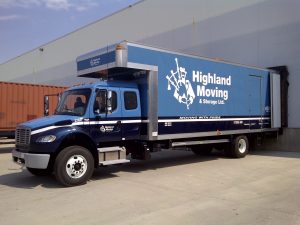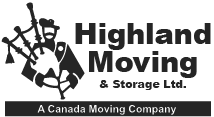FAQ - Frequently Asked Questions When Moving
100% Canadian Owned & Operated
The following frequently asked questions pertain to residential or household moving. If you do not see your questions answered in the list or require further details, please contact us.
If you are planning an office move or corporate relocation for your commercial business, you will find specific office moving frequently asked questions here.

Preparing for your move faq
The following is a list of frequently asked questions to help you begin preparing for your move.
Approximately 6 weeks. View our “6 Week Countdown Moving Checklist”, and our Moving Tips section for additional information.
No, your dressers can stay full, but be sure to remove any breakables.
Arrangements can be made through your Relocation Coordinator to have your stereo disconnected.
Arrangements can be made through your Relocation Coordinator to have your computer disconnected
The crew will place floor runners on all floors to protect against dirt, and damage.
Yes. It is recommended that you pack only unbreakable items, such as linens and books. Remember, all owner packed items travel at owner’s risk. Our Professional packing service is the best way to safeguard against breakage.
Your pack crew will bring special moving boxes and cartons to protect your paintings and wall hangings. Crews, however, do not remove any item that is secured to your walls including paintings. It is your responsibility to remove any “fixed” items from walls.
Yes. As a matter of public safety, governments at all levels have passed legislation restricting the transportation of dangerous goods. Some commodities may be included in your shipment under controlled conditions while law prohibits transport of others. In either case, you must disclose to the van operator every item you intend to include with your shipment that poses a hazard. A few prohibited items include: gasoline, propane tanks, oxygen, fire extinguishers, ammunition and fireworks. For a complete list of prohibited items, see below “Moving and Handling Dangerous Goods.”
Most machines and mechanical equipment do need to be prepared by a licensed professional before being moved. Your Moving Consultant can make these arrangements for you. It is important to remember that articles not serviced travel at owner risk for internal damage.
All items in your home will be inventoried (a detailed descriptive list of your household goods) on load day. Items are numbered and a brief description of the condition is listed on the inventory sheet. On delivery, you will check off each number as the corresponding item enters your home.
Transportation of special items faq
The following is a list of frequently asked questions to help you prepare specialty items for moving.
If you are moving within Canada , we will take your plants, but because some plants are susceptible to shock when moving, Highland accepts no liability.
If you are moving to or from the U.S. we cannot take plants.
For more information see our Moving Tips.
We cannot move propane tanks as they fall under the dangerous goods rule. For a complete list of prohibited items, see below “Moving and Handling Dangerous Goods.”
We do not move pets, but, if your company policy includes the movement of pets, your Relocation Coordinator would be happy to assist you with the arrangements. For more information and tips on traveling with pets, please see our “Moving your Pets” section in Moving Tips.
Batteries are classified as dangerous goods. For a complete list of prohibited items, see below “Moving and Handling Dangerous Goods.”
If you are moving within Canada , we do not move carbonated beverages, but will move all other sealed beverages at owners risk.
If you are moving to or from the U.S . you must meet age requirements. You can include up to 1.14 litres (40 ounces) of wine or liquor, or 24 x 445 ml (12 ounces) cans or bottles of beer or ale.
Any cleaners that fall under the dangerous goods act cannot be transported. For a complete list of prohibited items, see below “Moving and Handling Dangerous Goods.”
Yes, our crews are trained piano movers.
We can arrange the move of automobiles for you either by van or rail. For more information on moving your automobile, see “Vehicle Shipping And Transport“.
If you are moving within Canada , we can transport firearms, but not ammunition. For a complete list of prohibited items, see below “Moving and Handling Dangerous Goods.”
If you are moving to or from the U.S . you need to contact your local police department for information and paperwork required
Delivery of your household goods faq
The following is a list of frequently asked questions on what to expect when your household good arrive at your new home.
There are many factors affecting the length of time it takes for a shipment to travel from origin to destination: the distance, weight of the shipment, government regulations in the National Safety Code, Customs, weather, road conditions, and the need for ferries during transit. Allow extra time and be flexible when planning your moving schedule.
In the event your shipment can’t travel directly from origin to your new residence, Highland can arrange to place your belongings into storage until you are ready to receive them. All United Van Line Member companies are equipped with completely secure, clean warehouses and storage facilities. Storage is at an additional charge.
Upon arrival at destination, the driver will provide you with an “Inventory Check-Off Listing.” Each item is checked off as it is delivered. Any loss or damage is noted on the driver’s copy of the inventory in the section called “Exceptions on Delivery.” These observations will serve to substantiate a claim should you have reason to submit one.
Anything the crew takes apart at origin will be reassembled at destination.
Call your destination agent, whose name and phone number will appear on the top right corner of your bill of lading, and they will arrange a to pick up your moving boxes and cartons for you.
Moving and Handling Dangerous Goods
As a matter of public safety, governments at all levels have passed legislation restricting the transportation of dangerous goods. Some commodities may be included in your shipment under controlled conditions; others are prohibited by law. In either case, you must disclose to the van operator every item which poses a hazard and which you intend to include with your shipment.
Carriers such as moving companies van lines are required by the Transportation of Dangerous Goods Act to accept responsibility for the final decision whether any particular item can be safely included in your shipment. If your van operator feels it presents a danger to himself, his personnel, his vehicle or is contents, the law requires him to refuse to ship the item.
In order to prepare you in advance; we have developed the following lists of dangerous household commodities; some may be shipped and some may not. The items that are allowed to be included in your shipment must be handled according to the instructions listed under Allowable Dangerous Goods.
For those items which we cannot ship, it will be your responsibility to dispose of them before you move. Your van operator cannot do this for you. Most municipal landfill sites have the facilities to handle dangerous goods. Please do not attempt to conceal them within your shipment; this could place the van and its contents in serious danger; and also invalidate your liability protection.
- Household cleaners such as Ajax , Mr. Clean, Spic’n’Span
- Nail polish, polish remover and perfume
- Art supplies except those that are flammable, chemicals for photographic hobby
These allowable items must be packed in a carton clearly marked “Consumer Commodity – Dangerous Goods Exempt”. The carton must be pointed out to the van operator at the time of loading. You must declare that these are the only dangerous goods (as defined in the Act) that are included in your shipment; this declaration is included on your bill of lading.
Gases & Propellants
- Gasoline, propane, kerosene, naphtha, lighter fluid
- Liquefied petroleum gases of all types
- Aerosol cans not classified as personal toiletries
- Barbecue tanks, oxygen, helium, acetylene
- Butane lighters
- Fire extinguishers
Explosives
- Ammunition
- Fireworks
- Flares
- Blasting caps
- Industrial explosives
- Detonation devices
Flammable Solids
- Matches
- Solid fuel & BBQ starter tablets
- Sterno
- Hay, straw, wood chips
- Oily rags
Yard & Gardening Supplies
- Pesticides containing a base of arsenic, strychnine or cyanide
- Fertilizers containing ammonium nitrate
- Pool chemicals
- Chlorine
- Wood preservatives
Corrosives
- Battery alkaline or acid (except car battery installed in a car being shipped)
Household Chemicals
- Bleach & peroxide
- Disinfectants
- Cleaning fluids such as ammonia, verso, turpentine
- Pesticides, herbicides & fumigants
- Oven cleaner, lye or acids
- Oil-based paints & thinners
- Chemistry sets
- Any flammable items
Understanding the moving costs faq
The following is a list of frequently asked questions to help you understand all moving related costs.
The cost of your long distance move (in excess of 150 miles) is based on the weight of the items that are to be moved and the distance they will be traveling. The estimate outlines all of the services needed for your move and their costs.
Local moves are based on the time it will take to pack, load and deliver your shipment and the amount of labour required.
Consultants guarantee their estimates when they have all the necessary information to do so. For this reason, and to avoid complications at a later date, please be sure to point out everything that is to be moved. This includes all items in storage areas inside and outside of the house or anything being picked up from other locations, such as cottages or storage areas away from home.
If your employer is to be billed for the move, make arrangements well in advance with both your company and Highland Moving. This will help to avoid delays when your shipment is delivered.If you are paying for the move, Highland offers many payment options: cash, certified cheque, MasterCard, Visa, American Express, bank draft/money order. Credit card payments must be made in advance of delivery. As well, the driver cannot deliver a COD shipment until payment has been received.
This is when payment is required at the time of delivery.
This is the contract between the mover and the customer; it also acts as a receipt. It is important to understand everything on the bill of lading before you sign it.
This is an agreement to transport goods by a set date in exchange for a higher rate.
Guaranteed pickup or delivery is a premium service whereby dates of service are guaranteed, with the mover providing reimbursement for delays. This type of service is often subject to minimum weight requirements.
Services such as packing, appliance servicing, unpacking, or stair carries that are needed due to either your request or building regulations may result in additional charges
This is the basic method of billing for long distance moving services. Line haul charges are calculated by mileage and the weight of your shipment. Line haul charges may not include fees for charges such as the ones noted above in “additional charges”.
An additional charge incurred when articles must be carried an excessive distance to the movers truck.
Shuttle service occurs when a smaller vehicle is used to haul goods to a location that is not accessible to large moving trailers.
This is an extra charge for carrying items up or down flights of stairs.
Storage in transit is temporary warehousing of goods pending further transportation.
The amount your goods are worth. The valuation charge compensates the mover for assuming a greater degree of liability than provided for in the base transportation.
This is an additional charge applicable each time S.I.T. (storage in transit) service is provided. This charge compensates the mover for the physical placement and removal of items within the warehouse.


